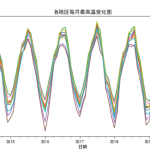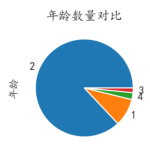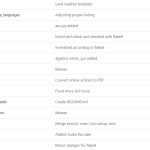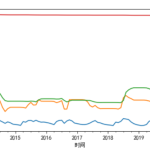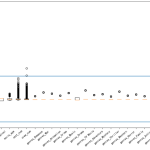10个Python脚本,轻松实现日常任务自动化
本文将向初学者介绍10个实用的Python脚本,帮助你轻松实现日常任务的自动化。这些脚本不仅能节省时间,还能让你更深入地了解Python的强大功能。
1. 自动整理下载文件夹
下载文件夹常常杂乱无章,这个脚本可以根据文件类型自动整理文件:
import os import shutil def organize_downloads(path): for filename in os.listdir(path): name, extension = os.path.splitext(filename) extension = extension[1:] if os.path.exists(path + '/' + extension): shutil.move(path + '/' + filename, path + '/' + extension + '/' + filename) else: os.makedirs(path + '/' + extension) shutil.move(path + '/' + filename, path + '/' + extension + '/' + filename) organize_downloads(r'C:\Users\YourUsername\Downloads')
这个脚本会遍历下载文件夹中的所有文件,根据文件扩展名创建相应的子文件夹,并将文件移动到对应的子文件夹中。
2. 批量重命名文件
在处理大量文件时,批量重命名是一项常见需求:
import os
def batch_rename(directory, old_ext, new_ext):
for filename in os.listdir(directory):
if filename.endswith(old_ext):
name_without_ext = os.path.splitext(filename)[0]
os.rename(
os.path.join(directory, filename),
os.path.join(directory, f"{name_without_ext}{new_ext}")
)
batch_rename(r'C:\Users\YourUsername\Documents', '.txt', '.md')
这个脚本可以将指定目录下所有特定扩展名的文件批量修改为新的扩展名。
3. 自动备份重要文件
定期备份重要文件是个好习惯,这个脚本可以帮你自动完成:
import shutil
import datetime
import os
def backup_files(source, destination):
today = datetime.datetime.now().strftime("%Y%m%d")
dest_dir = os.path.join(destination, f"backup_{today}")
try:
shutil.copytree(source, dest_dir)
print(f"Backup completed successfully to {dest_dir}")
except FileExistsError:
print(f"Backup for {today} already exists")
backup_files(r'C:\ImportantFiles', r'D:\Backups')
这个脚本会在指定的备份目录中创建一个以当前日期命名的文件夹,并将源目录中的所有文件复制到这个新建的备份文件夹中。
4. 监控网站可用性
对于需要保持高可用性的网站,定期检查其状态是非常必要的:
import requests
import time
import smtplib
from email.mime.text import MIMEText
def check_website(url, check_interval=60):
while True:
try:
response = requests.get(url)
if response.status_code == 200:
print(f"{url} is up!")
else:
send_alert(f"{url} returned status code {response.status_code}")
except requests.RequestException:
send_alert(f"Failed to connect to {url}")
time.sleep(check_interval)
def send_alert(message):
sender = "your_email@example.com"
receiver = "admin@example.com"
password = "your_password"
msg = MIMEText(message)
msg['Subject'] = "Website Alert"
msg['From'] = sender
msg['To'] = receiver
with smtplib.SMTP_SSL('smtp.gmail.com', 465) as server:
server.login(sender, password)
server.sendmail(sender, receiver, msg.as_string())
check_website("https://www.example.com")
这个脚本会定期检查指定网站的可用性,如果发现问题,就会发送邮件提醒。注意要替换成你自己的邮箱和密码。
5. 自动生成项目报告
在软件开发中,经常需要生成项目报告。这个脚本可以自动收集Git仓库的信息并生成简单的报告:
import git
import datetime
from jinja2 import Template
def generate_report(repo_path):
repo = git.Repo(repo_path)
commits = list(repo.iter_commits('master', max_count=10))
template = Template("""
# Project Report
Generated on: {{ date }}
## Recent Commits
{% for commit in commits %}
- {{ commit.hexsha[:7] }}: {{ commit.summary }} ({{ commit.author }})
{% endfor %}
""")
report = template.render(
date=datetime.datetime.now().strftime("%Y-%m-%d %H:%M:%S"),
commits=commits
)
with open('project_report.md', 'w') as f:
f.write(report)
generate_report('/path/to/your/repo')
这个脚本使用GitPython库来获取仓库信息,并使用Jinja2模板引擎生成Markdown格式的报告。
6. 自动化Excel数据处理
处理Excel文件是许多人的日常工作,Python可以大大简化这个过程:
import pandas as pd import matplotlib.pyplot as plt def process_excel(input_file, output_file): # 读取Excel文件 df = pd.read_excel(input_file) # 数据处理
这个脚本读取销售数据,计算总额,生成汇总统计和图表,然后将结果保存到新的Excel文件中。
7. 自动化PDF处理
PDF文件的处理也是一个常见需求,这里我们来看看如何提取PDF中的文本:
import PyPDF2
import re
def extract_text_from_pdf(pdf_path):
with open(pdf_path, 'rb') as file:
reader = PyPDF2.PdfReader(file)
text = ""
for page in reader.pages:
text += page.extract_text() + "\n"
return text
def find_emails(text):
email_pattern = r'\b[A-Za-z0-9._%+-]+@[A-Za-z0-9.-]+\.[A-Z|a-z]{2,}\b'
return re.findall(email_pattern, text)
这个脚本使用PyPDF2库提取PDF文本,然后使用正则表达式查找其中的邮箱地址。
8. 自动化图片处理
批量处理图片是另一个可以通过Python轻松实现的任务:
from PIL import Image
import os
def batch_resize_images(input_folder, output_folder, size):
if not os.path.exists(output_folder):
os.makedirs(output_folder)
for filename in os.listdir(input_folder):
if filename.endswith(('.png', '.jpg', '.jpeg')):
with Image.open(os.path.join(input_folder, filename)) as img:
img.thumbnail(size)
img.save(os.path.join(output_folder, filename))
batch_resize_images('original_images', 'resized_images', (300, 300))
这个脚本使用Pillow库来批量调整图片大小,同时保持原始宽高比。
9. 自动化网络爬虫
网络爬虫可以帮助我们自动收集网络上的信息:
import requests
from bs4 import BeautifulSoup
def scrape_quotes():
url = "http://quotes.toscrape.com"
response = requests.get(url)
soup = BeautifulSoup(response.text, 'html.parser')
quotes = []
for quote in soup.find_all('span', class_='text'):
quotes.append(quote.text)
return quotes
quotes = scrape_quotes()
for i, quote in enumerate(quotes, 1):
print(f"{i}. {quote}")
这个脚本使用requests库获取网页内容,然后用BeautifulSoup解析HTML并提取引用文本。
10. 自动化日志分析
分析日志文件可以帮助我们了解系统的运行状况:
import re
from collections import Counter
def analyze_log(log_file):
ip_pattern = r'\d{1,3}\.\d{1,3}\.\d{1,3}\.\d{1,3}'
with open(log_file, 'r') as f:
log_content = f.read()
ip_addresses = re.findall(ip_pattern, log_content)
ip_counts = Counter(ip_addresses)
print("Top 5 IP addresses:")
for ip, count in ip_counts.most_common(5):
print(f"{ip}: {count} times")
analyze_log('server.log')
这个脚本使用正则表达式从日志文件中提取IP地址,然后统计出现次数最多的IP地址。
结语
这10个Python脚本展示了Python在自动化日常任务方面的强大能力。作为一名经验丰富的Python开发者,我建议你不要止步于此,而是根据自己的实际需求,不断探索和创造新的自动化脚本。记住,编程的乐趣在于解决实际问题,而Python正是一个能让这个过程变得既高效又有趣的工具。
希望这篇文章能够激发你的创意,帮助你在日常工作中更好地运用Python。如果你有任何问题或想法,欢迎与我分享!





